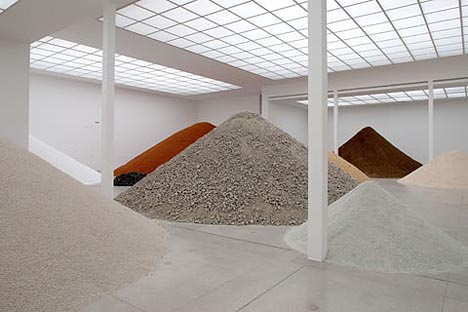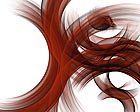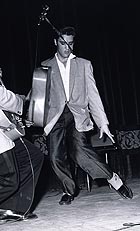
translated and summarized by: Liz Wollner-Grandville,
English summaries September 13 - 19
Secession
Lara Almarcegui
10.09.10 to 07.11.10
The whole as the sum of its parts
If the main room of the Vienna Secession would crumble, the building materials used in its construction result in 99 m³ of bricks, 43 m³ of concrete, 42 m³ of mortar, 30 m³ of Styrofoam, 24 m³ of terrazzo, 8.5 m³ of plaster, 7 m³ of wood, 2 m³ of glass and 0.5 m³ of steel. Lara Almarcegui now lays this to great effect before our eyes. She has piled up the said material masses whose aura-like effect makes one forget the mundane act of taking the factual inventory. Because the strategy of the artist, born in Spain in 1972 and living in Rotterdam, is above all, one of protocol, frequently based upon thorough research. In this context, urban wasteland has always been part of her research and is presented mostly in the form of publications, photographs and slide shows. For her Vienna solo debut, Almarcegui investigated the area of today’s North Station, which was abandoned after the end of the Second World War. The result of her findings is presented in the exhibition as a brochure, which includes information on the former strategic meaning, and texture of the future urban building development of the land as well as photographic images, which depict the venue as an indefinable all-purpose intermediate zone, contrary to its specific characteristics.
Almarcegui holds concepts, which understand art as a form of an outline of reality, against the analytical breakdown of existing circumstances in order to channel the eye towards mostly unnoticed details. That she doesn’t always find the path to such convincingly formal answers, as in “Construction Waste Main Room Secession”, is proven by the video in the Graphics Room. It prosaically documents the demolishing and relaying of the parquet floor, which, however, no longer shows any trace of this intervention. However, to involve the observer mentally as well as physically in spatial transformation processes, to sharpen his concentration on what for him would normally be hidden details, needs visible gestures as opposed to those of silent reference. In the past, artists at the Secession have proved this impressively.
Manisha Jothady
Secession, 1010 Vienna, Friedrichstrasse 12
www.secession.at
Opening hours: Tue-Sat 10 a.m. – 6 p.m., Sun 10 a.m. – 4 p.m.
Kunst- und Ausstellungshalle der Bundesrepublik Deutschland
Thomas Schütte – Big Buildings – Models and Views 1980 – 2010
15.07.10 – 01.11.10
The avant-garde concierge
Admittedly, the artist’s photo in the voluminous catalogue reminds one more of a melancholic concierge than of Thomas Schütte, or of that which one would like to imagine as a German avant-garde artist who has been hugely successful for many years: a blue blouson, a small-checked shirt, in the background foliage plants on the windowsill, a sloppy parting and, as the crowning touch, a pose emulating a Rodin’s “Thinker”.
However, he who enters the huge rooms of Bonn’s Federal Art Gallery comes face to face with an artist who, in many respects (amongst others) approaches his work on the basis of “think big”, and who must also be a top class aesthetic trapper and trap-builder. A short while ago, Thomas Schütte, who was born in Oldenburg in 1954 and who studied under Gerhard Richter and Fritz Schwegler in Düsseldorf’s Academy of Fine Arts in the 70’s, was awarded the Düsseldorf Kunstpreis. From Kassel, via Venice to New York, the exhibition catalogue leaves out little. Recently, it was shown in the House of Art in Munich and in the Museo Nacional Centro de Arte Reina Sofía in Madrid.
In Bonn, a brilliant show of his works are exhibited under the title “Big Buildings – Models and Views 1980-2010” which begins in a small way with the doll-sized, roughly patinated bronze “Man in the Mud” and ends in a large way with a completely different 5.80-meter high version of “Man in the Mud”. However, this last shows a monster in Styrofoam and plaster, a vacuous seeker with a divining rod in front of his breast and the mud, which embeds him only beginning just below the knee. It is clear that someone has caliber here and is capable of pulling the carpet out from under one’s feet. The adjunct “oddly familiar” is more applicable here than to any other artist – the title of a Düsseldorf exhibition in 2004.
Right from the beginning, Schütte’s theme is characterized by the work with architectonic models, often entire constructions in which small figures are poised: sometimes Schütte’s little house will even be represented as being occupied on a 1:1 basis. On the other hand, the play is a traverse between small and large, between model and realization, the whole work between art as a model and model as art. Schütte once said: “Just look out of the window and tinker with what you see outside”. Schütte is both a mixture of a conservative-to-kitschy hobbyist with, on the other side, a highly cynically filtered and genially alienated eye for the truth – a moralist and privy builder of a particular kind. Whether a “German petrol station”, a Bauhaus-like construction of yellow building components and tinted acrylic glass, is fashioned, or a “mountain” made of gaunt synthetic rock, deceptively authentically modeled with a Caspar David Friedrich cross on the top and a tunneled way through underneath with “One Way Ticket”: because there is no exit at the back of the mountain. Or the unimaginatively copied parking garage – all this is oddly familiar and, if nothing else, a thought-out model. Because the watercolor painting “Not so loud, we’re building here!” (2006), which depicts an exclamation mark, is meant as a thinking process and as nothing else.
In all, 60 works by Schütte are on display, above all architectural models and views, as well as walk-in spatial installations, amongst which those bunker models in celebration of the NATO Double-Track Decision or a gravestone with practical waiting room at the back. One is completely taken by a huge walk-in “Holiday Home for Terrorists”, a “Model for a Hotel” or the "One Man House" –constructions made of steel girders, Plexiglas or pressed boards. Everything is useful but completely useless for survival, whereby Schütte goes right to the fundament of a mentally homeless society. At the same time, Schütte asks: Are you still living or are you already alive?
Chimney and vent are never lacking in his models or his graphics, which address the phenomena “Museum”: so that the art may be cleanly burnt.
By Roland Groß
Kunst und Ausstellungshalle der Bundesrepublik Deutschland
www.bundeskunsthalle.de
Openings hours: Tue, Wed, 10 a.m. – 9 p.m., Thu – Sun 10 a.m. – 7 p.m.
Künstlerhaus Wien
paraflows .10 - mind and matter
10.09.10 – until 10.10.10
The ideals of digital culture
MIND AND MATTER – where is the dualism between mind and matter in digital art and culture to be found? What relevance lies ahead of the virtual and it’s apparent opposite, the object-like character, in today’s digital culture and society? What purpose does digital art fulfill in this context?
This theme of paraflows.10 will be discursively embraced in the symposium from 10-12 September at the Fifth Festival for Digital Art and Culture, and illustrated by artistic works at the exhibition in the Künstlerhaus.
The traditional theme of the clear definition and positioning of the non-material and the physical is no longer tenable in the digital context. Even if the one principle is conditional upon the other and the other’s needs, where does the spiritual end (up to now in the higher fields of the intellectually positioned) and, respectively, where does the territory of material matter begin (allegedly subordinate, earthly) when it comes down to hardware, software, program, process or simulation on the computer? Which of these presents an apparently real character? Especially, the capacity of artificial intelligence and „the net“ which, as it were, enlivens and literally merges into our everyday life, while at the same time creating a virtual society within a virtual reality, eliminates, in principal, every traditional hierarchy. The former antitheses of mind and matter have, in this context, imbued themselves; new dimensions have superseded components such as time and expansion. In the paraflows.10 catalogue, high claim is laid upon digital art: as the “bearer of a utopian as well as a practical, enlightening potential” it shall be effective in helping to fashion “the concrete practice as well as this consolidated theory”. The “artificial consciousness” which will become the collective consciousness of the digital society, shall, with the help of art, be emancipated, influenced and formed by capitalistic interests. Digital art is therefore politically relevant.
The exhibition in the Künstlerhaus displays the history as well as the diversity of the forms of digital art. As early as the 70’s, Zelko Wiener deals with the figural presence of digital characters and codes. Peter Kogler presents the idea and its elusiveness in the pulsating projection of a brain and, at the same time, confronts this as software with its hardware, i.e. with its material organic existence, staged as a computer-shaped form protected by a showcase. Lia visualizes imaginary spaces in an interactive generative work of variably adjustable parameters. Following the insolvency of her business, Celine Berger processes the different voices of employees in an audio installation in whose overall composition various levels of meaning are instantaneously and simultaneously realized. Niki Passath presents expanding and contracting architectonic modules in a communicative and reactive robotic system; Julian Palacz has captured the movements of the computer mouse.
The exhibits are truly diverse, interesting, aesthetic, innovative and inspiring; the virtual finds its polymorphic manifestation in a concrete, sensuous form. However, the above-cited deliberation / meditation / musing on art appears cathartic, all too ideal – or also, perhaps, excessive or romantic: in this respect, the materialization of the theory is, assuredly, still utopian.
By Margareta Sandhofer
Künstlerhaus Wien, 1010 Vienna, Karlsplatz 5
www.k-haus.at
Opening hours: daily from 10 a.m. - 6 p.m.
Folkwang Museum
A Star is Born – Photography and Rock since Elvis Presley
02.07.10 - 10.10.10
From the eyes to the ears
A few years ago, at one of his last German concerts, the guards were really tough. It wasn’t about elderly girls who wanted to foist a “sex bomb” on an even older tiger called Tom Jones. Instead, the guards gripped the photographers who, after the first officially allowed minutes for press photography, wanted to take further shots from behind the scenes at the concert. Even an older tiger takes care of his image, especially if he no longer transpires as photogenic as before.
Anyhow, in light of the abstract world of musical tones and especially in terms of the short-lived pop and rock scenes which are supposed to remain in the memory as commercial turnovers, it definitely boils down to: what’s left are the pictures. Star photography is spared the credo of the newly discovered photography of the 1920’s “Show what’s what”. Not to mention the perfected newly created supreme ‘chart-beings’ of our times, via computer programs such as Photoshop. And don’t forget YouTube, video clips and the Internet as new strategic marketing fields. All past, all over.
However, an exhibition in Essen’s Folkwang Museum nostalgically proclaims “A Star is Born – Photography and Rock since Elvis“, and looks back, supported by record covers, news clippings and autograph cards and, last but not least, by star cut-outs from “Bravo”. Above all, Ute Eskildsen, one of Otto Steinert’s students and, since many years, head of one of the most important photograph collections in the Republic, has resorted to 250 photographs to help bring back 60 years of photographic star cult to the public’s mind. From Elvis Presley in sweaty black-and-white to Annie Leibovitz’s clean creations.
Before Elvis came to Bremerhaven in his GI look, Alfred Wertheimer photographed a youngster playing the guitar called Elvis Presley in 1956: still a nobody who was looking for paper towels in a train washroom, who had a record player on his lap and listened to his own single (!) and who stumbled out of the station in Richmond, Virginia, with a portable radio in his hand: no sign of caring for his image and public relations, release for publication and exclusive photo contracts or even personal photographers who, admittedly, didn’t underestimate the classical branch – and don’t only look at Herbert von Karajan.
Since the 1970’s, the rock stars are no more different than today’s large concerns who adopt a corporate identity that is supposed to remind the public of their existence by means of certain colors, designed language, cultural assistance measures or type fonts. One only has to think of Frank Zappa’s loutish image: the rock star sitting on the lavatory – a poster icon. Salary and guise amalgamate. Above all, the record covers acted strongly to imprint the image of the stars’ photos on the mind: think about the Beatles in Abbey Road or the Rolling Stones with the Sticky Fingers zipper created by Andy Warhol: smart lads and large-mouthed underdogs, and the picture is complete. And it flows from the eyes to the ears, then to the jerking legs and upper body, culminating in a well-filled purse
It’s good to read the interview with the philosopher, Theodor W. Adorno, who, in 1969 said: "The union between protest and popular music is condemned to failure. Vietnam and slushy songs – those don’t go together”. Intrinsically, he was wrong - but we were talking about the jargon of authenticity – and that in another exhibition.
By Roland Groß
Museum Folkwang
www.museum-folkwang.de
Tue - Sun 10 a.m. - 6 p.m., Fri 10 a.m. 11:30 p.m.
Mehr Texte von translated and summarized by: Liz Wollner-Grandville


 Teilen
Teilen




